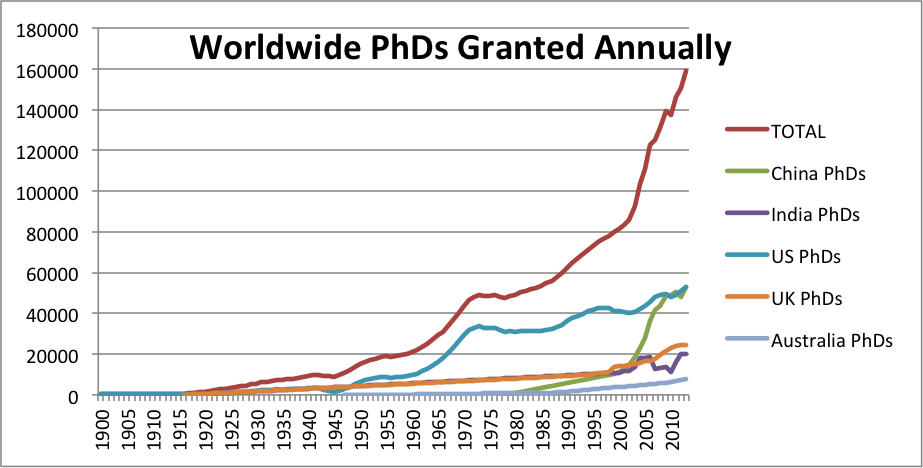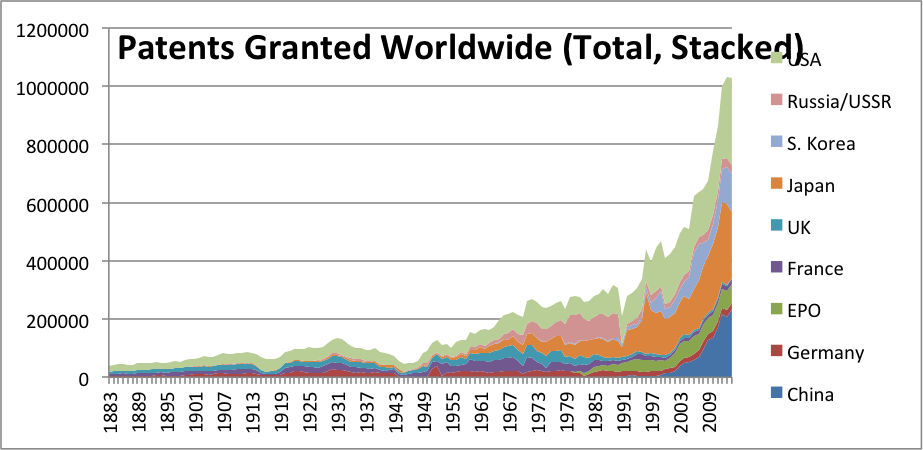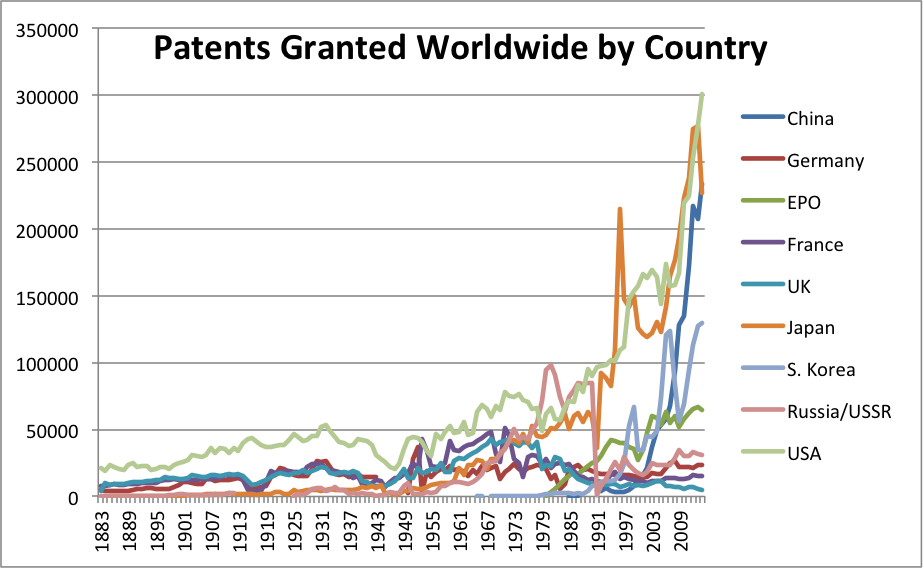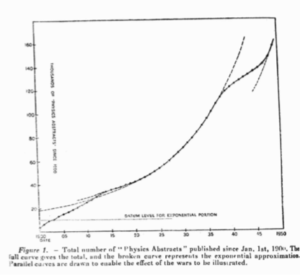90% of All the Scientists That Ever Lived Are Alive Today

Contents
Click here to see this page in other languages: German![]()
The following paper was written and submitted by Eric Gastfriend. The information he presents is helpful to keep in mind as we consider the speed with which technologies are advancing today.
90% of All the Scientists That Ever Lived Are Alive Today
This simple statistic captures the power of the exponential growth in science that has been taking place over the past century. It is attributable to Derek de Solla Price, the father of scientometrics (i.e., the science of studying science), in his 1961 book Science Since Babylon. If science is growing exponentially, then the major technological advancements and upheavals of the past 200 years are only the tip of the iceberg.
The implications of exponential growth are notoriously difficult for us humans to wrap our minds around. Legend has it that when the game of chess was invented, the king of India was so taken with the game that he offered the game’s inventor any reward he wished for. The inventor asked for grains of rice – specifically, one grain for the first square of the chessboard, two grains for the second square, four grains for the third square, and so on doubling for each of the 63 squares. The king laughed and granted this request, considering it to be a meager request for so grand an achievement. The king, along with any schoolchild who has heard this story, was surprised to learn that to fulfill this request would require 1,000 times more rice than exists in the world, and would be the size of Mt. Everest. Our intuition is not built to handle the concept of exponential growth.
Luckily, unlimited exponential growth is impossible on Earth (otherwise, we’d be left with no Earth). Although we still hear de Solla Price’s statistic repeated today, we need to ask, does this fact from over 50 years ago still hold true? Is science still increasing exponentially?
tl;dr: Yes and yes.

Price correctly argued that the trend could not continue indefinitely, or we would have more scientists than people (zombie scientists?). However, he also thought that science was already reaching “saturation” in 1961. David Goodstein, a physicist at Caltech, gave a speech in 1994 arguing that The Price Was Right and we had already hit “The Big Crunch” where progress in science slows down, based primarily on data from the US.
In order to investigate this question, I gathered data on 3 indicators of the growth of science: the number of PhD’s granted per year, the number of patents issued, and the number of papers published. For all of these, I have sought to get worldwide data, or at least data from the major countries.

For PhD’s granted, I was able to find data for the US, UK, Australia, India, and China, from each country’s ministry of education website. Data for the US goes back to 1900, but for most of the other countries it only goes back to 1999, so I used a linear extrapolation for those countries back to the date when the first PhD’s were granted for that country. The chart shows that the US grew exponentially until 1971 when it started to level off. But in the 80’s, with Deng Xiaoping in office in the wake of the Cultural Revolution, China begins to pick up the slack, such that the overall world production of PhD’s continues to grow exponentially. In 1961, de Solla Price noticed that the number of scientists was doubling roughly every 15 years. My data show that since 1961, this rate has slowed down slightly, with a doubling roughly every 18 years. Still growing pretty freakin’ fast.
Calculating the percentage of scientists currently alive involves some guesswork. If we assume each scientist is 27 years old when they receive their PhD, and 80 years old when they die, then in my model the PhD grantees from 1959-2012 are alive, and those from 1900-1959 are dead (my apologies if I have given you an untimely death). By that measure, exactly 90% of all scientists that ever lived are currently alive. Of course, this ignores scientists that lived before 1900, although I expect that number to be small relative to the millions of scientists alive today. Technically, de Solla Price said it was 80-90%, so within that range of uncertainty, the statistic probably still stands.
This extrapolation shouldn’t affect the results too much because compared to the US, these countries all had relatively few PhD’s being granted in 1999.


As you can tell from a quick glance at the chart, growth in patents has continued to be exponential. If you look closely at these charts, you can see the impact of many historical events. For example, the fall of the Berlin Wall and end of the Soviet Union brought patent grants to nearly 0 in 1991. Similarly, 1991 cause a huge drop in patent grants in Japan, since that was the year the Japanese economic bubble popped. WWI and WWII both caused drops in global patent issuance. You may notice that the global total seems to drop off a little at the end – this is due entirely to a 20% drop in patents granted in Japan in 2014, which is a time-lag effect of the 2008 financial crisis. The growth rate is similar to that of PhDs, with a doubling roughly every 19 years since 1961.
Papers Published
Analysis of scientific papers published, which was pioneered by de Solla Price, has been well-studied in the academic literature. The most recent, most broad, and most sophisticated analysis I’ve found comes from the paper “Growth rates of modern science: A bibliometric analysis based on the number of publications and cited references” by Lutz Bornmann and Rüdiger Mutz. This paper, along with others in the field of scientometrics, confirms the exponential growth of science – it “has become today a generally accepted thesis.” They show that in the second half of the 20th century, the number of papers published annually was doubling every 9 years.
For patents granted, the data up to 2006 comes from the WIPO Statistics Database, and after that comes from WIPO and individual countries’ patent office websites. The EPO is the European Patent Office, founded in 1977. The data show it has eclipsed national European patent offices in importance, as part of the trend of greater European integration.
Note that the apparent drop-off at the end of this chart is just an artifact of their estimation technique – they are looking at citations from papers published in 2012 to count papers published in previous years, so the most recent papers haven’t had enough time to be cited yet.


The graph on the left closely resembles Derek de Solla Price’s original curve, showing exponential growth in Physics abstracts, 1900-1950 (graph on the right).
Possible Objections
You might be willing to accept the data presented above, but still disagree with the conclusion that science is actually advancing exponentially.
Objection: Science is Getting Harder
When Sir Isaac Newton discovered the law of gravity in 1665, there weren’t many other scientists around, so there were a lot of low-hanging fruit (get it?). Revolutionary scientific discoveries used to happen quite frequently, but we’re unlikely to get anything as revolutionary as General Relativity in the coming decade. In other words, the recalcitrance or difficulty of making scientific discoveries may be growing exponentially even faster than the number of scientists we’re throwing at the problems.
I think this is true, but there’s a countervailing force to consider. Science builds on itself. Advances in statistics lead to advances in machine learning; the progress of electrical engineering that powers Moore’s Law makes those advances in machine learning practical; and those techniques benefit fields ranging from computational biology to social network theory. So while it’s vastly more difficult for an individual scientist to make significant breakthroughs today, there’s a million-fold multiplier on even small advances from all the scientists worldwide who can build upon that work.
Objection: We’ve Lowered our Standards
Sure, we’re producing more people with the letters PhD at the end of their name, and we’re publishing more papers, but it’s become meaningless. Most published research findings are false. Patents get granted for ridiculous things. The rapid growth of China’s PhD programs may have come at the expense of quality.
There may be some truth to this argument, but let’s see what it implies. Suppose that in the glorious scientific past, in the year 1900, 2/3 of published research findings were replicable, and that now it’s only 1/3. We calculated above that the total number of papers published doubles roughly every 15 years, which means we have had 7 doublings in the 20th century. If the quality has been cut in half since then, we would be left with 6 doublings of “quality science.” That’s not enough to break the argument. Besides, we should be careful not to glorify the past. Would Freud’s work pass for respectable science today?
Conclusion
Science and technology have drastically transformed our lives. This revolution has taken place almost entirely in the past 200 years – one tenth of one percent of our species’ 200,000 year history. Never before have we had so many people whose sole purpose of work is to better understand how the world works. This has far-reaching implications, both good and bad, for the future of humanity. It’s difficult to wrap our minds around the blistering pace of innovation that is about to come.
As Mr. Bean once said, “Brace yourselves.”
Special Thanks to my research assistant Eitan Kling-Levine for helping me gather this data.
Bibliography
“Annual Reports.” University Grants Commission of India, n.d. http://www.ugc.ac.in/page/Annual-Report.aspx.
Baker, Monya. “First Results from Psychology’s Largest Reproducibility Test.” Nature, April 30, 2015. doi:10.1038/nature.2015.17433.
Bornmann, Lutz, and Ruediger Mutz. “Growth Rates of Modern Science: A Bibliometric Analysis Based on the Number of Publications and Cited References.” arXiv:1402.4578 , February 19, 2014. http://arxiv.org/abs/1402.4578.
Chatterjea, Arkadev. “Doctoral Education and Academic Research (in India).” Cornell University ILR School, February 2006. http://digitalcommons.ilr.cornell.edu/cgi/viewcontent.cgi?article=1066&context=workingpapers.
“Data Coverage.” Engpat.kipris.or.kr. Korean Intellectual Property Rights Information Service, n.d. Web. 28 Aug. 2015.
“Discussion Paper: The Changing PhD.” Group of Eight. Accessed September 10, 2015. https://go8.edu.au/publication/discussion-paper-changing-phd.
Dobson, Ian R. “PhDs in Australia, from the Beginning.” Australian Universities’ Review, 2012. http://files.eric.ed.gov/fulltext/EJ968535.pdf.
“European Patent Granted 2005-2014 per Country of Residence of the First Named Applicant.” Epo.org. European Patent Office, 3 May 2014. Web. 28 Aug. 2015.
“Facts and Figures: 2013 and 2014.” UK Intellectual Property Office, 2015. https://www.gov.uk/government/uploads/system/uploads/attachment_data/file/456097/Facts_and_Figures_2015.pdf.
Fiegener, Mark K. “Science and Engineering Doctorates.” nsf.gov. National Science Foundation, Dec. 2014. Web. 24 Aug. 2015.
“Free Online Statistics – Students & Qualifiers.” Higher Education Statistics Agency (UK), n.d. https://www.hesa.ac.uk/data-and-analysis.
Kurup, Anitha, and Jagdish Arora. Trends in Higher Education: Creation and Analysis of a Database of PhDs in India. Rep. Bangalore: National Institute of Advanced Studies, 2010. National Institute of Advanced Studies. May 2010. Web. 26 Aug. 2015. .
“Ministry of Education of the People’s Republic of China_MOE.GOV.CN.” Ministry of Education of the People’s Republic of China_MOE.GOV.CN. Moe.gov.cn, n.d. Web. 24 Aug. 2015
“National and Regional Office IP Statistics and Annual Reports.” World Intellectual Property Organization, n.d. http://www.wipo.int/ipstats/en/resources/office_stats_reports.html.
National Science Foundation, Division of Science Resources Statistics, U.S. Doctorates in the 20th Century, NSF 06-319, Lori Thurgood, Mary J. Golladay, and Susan T. Hill (Arlington, VA 2006).
“The Number of Applications and Registrations in 2014.” Https://www.jpo.go.jp. Japan Patent Office, July 2015. Web. 28 Aug. 2015.
Price, Derek John de Solla. Little Science, Big Science: Derek J. de Solla Price. London, 1963.
Price, Derek John de Solla. Science since Babylon. Yale University Press, 1961.
“Statistics.” Japan Patent Office. Accessed September 9, 2015. http://www.jpo.go.jp/english/statistics/statistics/index.html.
“Statistics.” Korean Intellectual Property Office, n.d. http://www.kipo.go.kr/kpo/user.tdf?a=user.english.html.HtmlApp&c=97000&catmenu=ek07_03_01.
“Statistics.” State Intellectual Property Office of the P.R.C. Accessed September 9, 2015. http://english.sipo.gov.cn/statistics/.
“The Big Crunch.” NCAR 48 Symposium, Portland, OR, September 19, 1994. http://www.its.caltech.edu/~dg/crunch_art.html.
“Wheat and Chessboard Problem.” Wikipedia, the Free Encyclopedia, September 4, 2015. https://en.wikipedia.org/w/index.php?title=Wheat_and_chessboard_problem&oldid=679446194.
“World Intellectual Property Organization.” WIPO –. N.p., n.d. Web. 26 Aug. 2015.
About the Future of Life Institute
The Future of Life Institute (FLI) is a global think tank with a team of 20+ full-time staff operating across the US and Europe. FLI has been working to steer the development of transformative technologies towards benefitting life and away from extreme large-scale risks since its founding in 2014. Find out more about our mission or explore our work.
Related content
Other posts about Guest post

The Impact of AI in Education: Navigating the Imminent Future

The Future and the Artificial: An Islamic Perspective

On AI, Jewish Thought Has Something Distinct to Say

